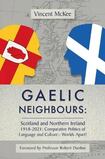
This study does what it says on the cover. It might seem to be an obvious object of interest given the close cultural ties of Ulster and Scotland, but it has never been done before with such detail and information. It is a study of the often-contrasting fortunes of Gaelic and Irish with the word “culture” encompassing the arts and sport in a broad historical, social and political context.
Patterns emerge from the sweep of detail. Speakers of Gaelic were even more worsted in the game than Irish speakers were, and a pall of despond descended on the Scottish highlands after the slaughter of the first World War. This was no time for a renaissance. It took much patient work by dedicated individuals and organisations over decades to prepare the ground for any kind of cultural recognition. The Scottish National Party was wary of the language movement given the fractious nature of Scottish identity, but patient lobbying and the liberal climate of the 1960s opened up greater opportunities despite the usual ignorant opposition. This resulted in a boom in publishing, Gaelic radio and television programmes, and Gaelic-medium education.
Northern Ireland is not treated in isolation from the rest of the country, and Ulster means the nine counties, but it is the focus of the study. The attempt to gain more recognition and rights for Irish was more contentious as it faced serious political opposition by the unionist establishment and much indifference by the southern State. On the other hand, there was a greater dynamism linked to the new-found confidence of the northern nationalist community. While this is obviously involved with politics, McKee has the good sense to see it as part of the resurgence of the GAA in the province, as well as the strength of local feiseanna, music, art and literature, all part of a greater Irish culture. Not surprisingly, he takes a swipe at “the narrow-minded imagery of many southern Irish people” with their ahistorical partitionist mentality.











